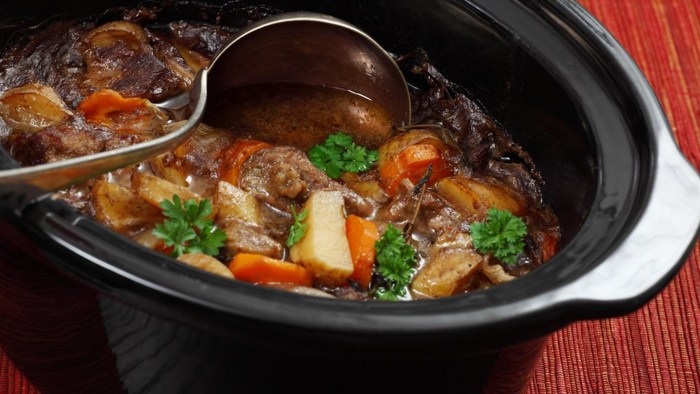
The slow-cooker can be a godsend if you use it right – allowing you to multitask while it does the cooking work for you. But you run the risk of ending up with a mushy meal that’s not quite right. Use these tips for what to do and what to avoid to ensure you’ve got a winner every time.
Start with the correct cut of meat
Slow cookers work well with fattier meat cuts—think a pork shoulder, short ribs, or flank steak—cooking low and slow since the fat keeps the meat moist. Fattier cuts are usually cheaper, so it’s a total win-win. Does this mean that lean cuts like pork tenderloin or chicken breasts can’t be used in a slow cooker? No, but proceed cautiously. A long cooking time could cause stringiness, so aim for a shorter stint and extra liquid to prevent lean meats from overcooking.
Layer food properly
Remember that the slow cooker’s heat source is directly on the bottom. Whatever food will take the longest to cook needs to be placed into the slow cooker first to absorb the most heat. This usually translates into tougher cuts of meat and root vegetables like sweet potatoes or winter squash. This same thought process also holds true for more delicate, quick-cooking veggies like peas or chopped string beans being layered at the top of the slow cooker pot during the last 30 minutes, so they don’t turn into overcooked mush.
Get tons of slow-cooker recipes and ideas here!
Don’t overfill the slow cooker
Always try to err on the side of “less is more” when it comes to adding food into the slow cooker, aiming to fill it around two-thirds full. Filling the slow cooker directly to the top leads to one main problem—the food begins to steam versus simmer, resulting in a much longer cooking time and not as tasty results.
Keep the lid closed!
Sure, it’s tempting to take a peek at the food by opening the lid, but it’s best to keep the lid closed shut. Bruce Weinstein and Mark Scarbrough, authors of “The Great American Slow Cooker Book,” estimated that just one lift of the lid could result in adding 30 minutes more of cooking time. Keep this in mind each time you’re wanting to check on the cooking process. Of course, disregard this rule if you’re stirring food into the slow cooker at the end of the cooking time since the dish is almost done at that point.
Add dairy and herbs at the end
Let’s say you’re making veal paprikash or beef stroganoff in the slow cooker. Only stir in the sour cream or crème fraiche—or any dairy in a slow cooker recipe—right at the end of the cooking process, like the last 30 minutes. Doing so beforehand will lead the dairy to curdle. The same goes for fresh herbs like basil leaves in a slow cooker marinara sauce; only add during the last 30 minutes or they’ll wilt too much. Both dairy and herbs can’t hold up to the long cooking time and temperature in a slow cooker.
Brown the meat
The extra step of browning meat in a slow cooker dish like a roast or ribs has two bonuses to it. Sure, there’s an extra pan to wash (unless your slow cooker has a stovetop-safe insert), but the benefit is that the browned meat will give the dish a bit of a more complex, heartier flavor. Don’t have the time to get the meat golden-brown? Don’t stress about it. It’s an added incentive for a better meal but not necessary all the time.
Don’t overdo the booze
When adding alcohol like white wine or sherry into a dish, keep it to just a splash if involved in a slow cooker recipe. The alcohol doesn’t have a chance to boil off, leaving a raw boozy taste.
Let liquid boil off
Sometimes vegetables like onions release too much liquid in a slow cooker recipe, making the cooking sauce too thin. If the meat is cooked and you were aiming for more of a gravy-consistency from the dish’s sauce, place the slow cooker on a high setting and remove the lid for 30 to 45 minutes. This will allow the extra moisture in the sauce to boil off.
Be flexible with time and temp
Did your slow cooker recipe not turn out exactly as the recipe described? Don’t worry. The reason is because slow cookers vary so much -one might run hot while another may take longer to spring into heating action. Experiment with the temperature of your slow cooker and the time needed for specific meats.
Not just for dinner
If you’re only relying on the slow cooker for dinner needs, you’re missing out on a slew of other options. Use it to create a chicken stock or chicken broth or run it overnight for slow cooker oatmeal or braised breakfast ham. How about a slow cooker dessert like poached apples or a berry crispy? Keep in mind how versatile the slow cooker can be to harness more use out of it.
See full story on today.com